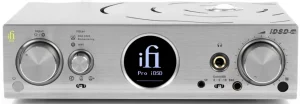
ON TEST
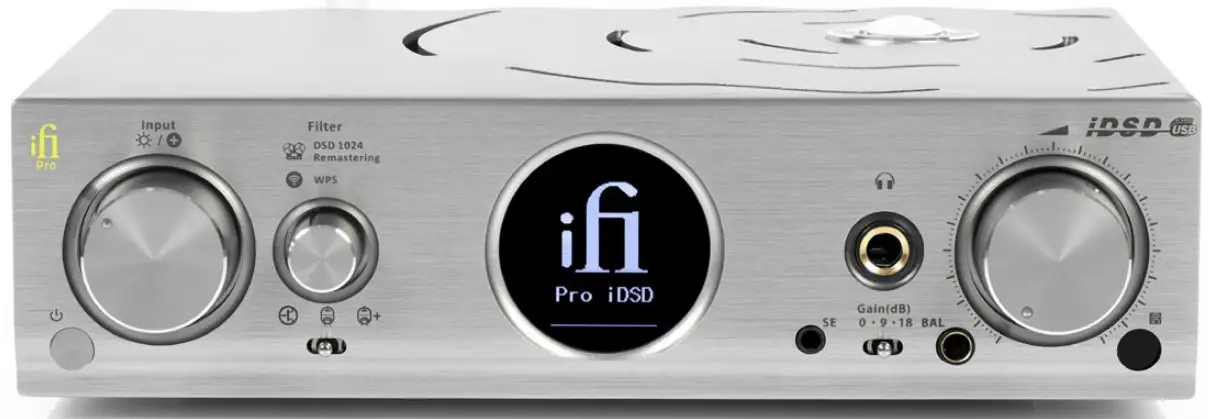
ifi
Pro iDSD
DAC/HeADpHone Amp/StreAmer
Sick of having to pick and choose? Want product A because it has this feature, but you’d also like that feature that is only in product B? But product B doesn’t have the first feature. Well, the iFi Pro iDSD is, I think a device that eliminates that problem. I don’t think that there is a feature that it doesn’t have. And its feature set includes support for audio formats that either don’t even exist yet or are so rare you’ll have a lot of trouble finding them.
THE EQUIPMENT
The iFi Pro iDSD is a combined DAC, headphone amplifier, and network audio streamer.
Let’s look at each of those three functions.
As a DAC, it supports pretty much everything, now and into the future.
Specifically, it supports PCM at up to 32-bits and 768kHz sampling. I haven’t been able to find any music yet at more than 384kHz sampling and those were all demo tracks. See what I mean about covering the future? Trivially, it also supports DXD and double-DXD. I say trivially because DXD is simply PCM with 352.8kHz or 384kHz sampling.
It also supports DSD. Not only just regular DSD64. Not only just double-speed DSD128, quad-speed DSD256, nor octa-speed DSD512. No, it goes all the way up to 16× DSD1024.
(Which is all well and good, but if HiFi’s own specifications are right, all forms of DSD are finished off with a 3rd-order analog filter at 80kHz.) And with the latest firmware, it supports MQA.
There are inputs for a USB 2.0/3.0 connection to a computer (Windows or Mac).
This is what you’ll use for your 16× DSD files! But you can also plug in a USB memory stick or hard disk and playback content from
that. Or a microSD card. Or plug in an external digital source via either a coaxial or optical connection. This uses a single, unusual socket combo, with a 3.5mm optical connection in the hole of an RCA socket. A standard Toslink to 3.5mm optical adaptor is provided with the unit. Finally, you can feed in professional-grade AES-EBU digital audio via an XLR connector. There is also a BNC socket that allows the decoded signal to be clocked by an external source, something of importance in some studio contexts.
various types of clock sources.
A front panel display shows the signal format, sampling rate, input selected, and processing. By ‘processing’, I mean you get a choice of four different filter types, or the option to convert the signal internally to DSD512 or DSD1024 before decoding. That brings us to the headphone amplifier. This has five outputs, three of them for headphones. One is 6.35mm, one is 3.5mm and one is 2.5mm balanced.
Very recently the unit has also become to be made available in a different version with a 4.4mm balanced headphone output rather than the 2.5mm socket. (This otherwise identical unit attracts a price premium that puts its RRP at $3,999.)
At the back are RCA and balanced XLR line outputs. A switch next to those allows you to select variable output level or fixed (maximum) output level for both, at home audio levels or (higher) pro audio levels. The volume control is a high-quality analog one. It’s powered—a small remote control that operates only the volume is included.
When you switch the unit on, the motor turns the volume control from the zero position back to where you last left it. It goes back to zero when you switch it off.
You can use the headphone amplifier in three modes (there’s a switch on the front):
with Class-A JFET solid-state output, with Class-A output using GE5670 valves, and with the valves but with reduced negative feedback.
Finally, as a network streamer, the iFi Pro iDSD acts as a DLNA renderer and a network ‘speaker’ for such things as Apple Airplay and Spotify Connect. The recommended app also includes support for iHeartRadio, TIDAL, Napster, and Qobuz.
I could fill a big chunk of this issue of Australian Hi-Fi Magazine by including with this review explanations of all the high-end features of this DAC, including the zero jitters buffering, the galvanic isolation of the inputs including USB, the use of multiple BurrBrown DACs, the inclusion of a field-programmable gate array for filtering and much more. I just don’t have the room for that, so let’s just accept that the iFi Pro iDSD is full of high-quality, high-tech components.
SET-UP
Given that the iFi Pro iDSD has such extraordinary capabilities, you’d expect to see an
Very recently this the unit has also become to be made available in a different version with a 4.4mm balanced headphone output
impressive Owner’s Manual. But the manual supplied with my review unit was weird. It detailed the inputs and outputs, and had several pages of design notes about what goes on inside the iFi, all of which was very welcome… but it did not provide a single word about the installation of the unit with your computer, nor really go into oddities such as the combined RCA/Optical socket for digital audio input. Nor is there anything in the manual about setting up Wi-Fi, apart from the mention of the ‘Muzo’ app. Also, no Windows drivers are provided in the box. There is a Windows driver available on the website, but I hesitated to use it because the Pro iDSD is not one of the products listed for use with it.
However, in the absence of anything else, it seemed that I had no alternative other than to try that driver.
I downloaded and installed it and it turned out that this was indeed the required driver. There was one more step needed, though. As delivered, the unit had firmware version 1.60 installed, but there was a new firmware version—2.01—available on the iFi website.
This adds MQA support. Installing it was easy enough using a utility that was installed as part of the driver installation. Just a word of caution: switch off the amp into which the device is plugged before you start. It produced a nasty crack through my speakers when the unit switched off. In normal use, switch-off was typically graceful.
The next step was to set up the network connectivity. Yes, I have an Ethernet cable near to where I installed the iFi Pro iDSD, but I decided to try to figure out how to install the unit via Wi-Fi. Let me repeat, there were no instructions… nor could I find any on the
website. This really is a significant oversight which hopefully may be rectified by the time you read this review (or shortly after someone
at iFi reads this review!).
Anyway, installing the Muzo app did no good. All it did was look for a suitable device on the network. But first I had to connect the Pro iDSD to the network. Next step, I went to the Wi-Fi settings on my phone and found that there was an access point called iFi_HiRes_Audio_D874’. I connected my phone to it. The next one would typically type the IP address of the unit into a web browser to bring up a setup page, but what was it? I decided I needed an IP address scanner. Back on my regular Wi-Fi connection, I installed one from the Play Store. Then, back on the fire Wi-Fi connection, I ran the scanner. It turned out its IP address was 10.10.10.254. I put that in the web browser on my phone and it brought up a page to connect to my regular network.
I tapped an access point and after a few seconds, a female voice announced from my speakers that the fire was plugged in—‘Wi-Fi connected’. Hours later, closely examining the front panel of the unit, I noticed that the control for the filter is also marked ‘WPS’.
That would allow one to connect easily to a Wi-Fi router with WPS functionality, which is most of them. I do not like using WPS.
IN USE
The front panel display of the iFi Pro iDSD was excellent, showing exactly what was happening with the signal. At the bottom, it shows the input and the sample rate of the signal. If you make a mistake in setting up your player software on a computer, you’ll soon become aware of it. At the top, the main processing is shown. This is PCM (for the bit-perfect and bit perfect+ filters), DXD for the other filters when used with PCM, and DSD, DSD 512, or DSD1024. The latter two are when the input is being reprocessed. In the middle, a large figure shows the frequency at which the signal is being processed. Both DXD and DSD show different numbers, depending on whether the input signal is based on 44.1kHz-type signals (for example 88.2kHz) or 48kHz-type signals (for example 96kHz). This shows that the upsampling or DSD conversion retains all the original samples but adds intermediate ones.
I was able to test the unit with PCM signals up to 384kHz sampling, and DSD up to DSD256. All of these worked perfectly when fed from my computer. I had trouble getting the complicated Foobar2000 DSD setup to work so I switched over to the much easier-to-configure JRiver Media Centre software and it fed through those signals bit-perfect…
with the right settings. I complained about the weaknesses of the manual, but the is the website does have several very useful documents for setting up various versions of Foobar 2000 and JRiver to properly stream DSD.
I used the RCA line outputs for listening through my system, with output set to ‘Pro Fixed’, plus the headphone outputs. So, why ‘Pro (Fixed)’? Aren’t I a hi-fi guy?
Well, I did listen for a while with ‘HiFi (Fixed)’ and, in fact, the sound was rather harsh.
That surprised me. The reason seemed to be that it was, well, too loud, perhaps overloading the line input a bit. So I did some checking.
Using the RCA outputs, the output voltage of a 1kHz sine wave, modulated to peak at full scale, was 4.98-volts RMS with the output control set to ‘HiFi (Fixed)’ and 2.24-volts RMS with it set to ‘Pro (Fixed)’. The two variable settings matched the respective fixed settings when the level knob was turned completely to the right.
So, in short, the ‘HiFi’ settings were high output and the ‘Pro’ settings were low output. Which is the reverse of usual practice, and the reverse of what the manual says. So that’s why I did all my system listening using the Pro setting.
And with that setting, the sound produced by this unit was first class. It was authori- native, controlled, and detailed. In a word, unimpeachable.
That continued with headphone use.
Inserting a headphone plug into one of the front sockets switches off the line outputs.
I had models to hand ranging from 16Ω to more than 500Ω impedance. Some had even impedances across their operating range, while others had wide variances.
All of them sounded as good as I have ever heard them, and several of them sounded far better than with a lot of other equipment. I have written previously about certain design weaknesses in headphone outputs. This unit appeared to exhibit precisely none of them.
So it, too, was authoritative, controlled, and detail into all different headphone models. And it was powerful. It easily drove all of them to the maximum of their ability, and my ears, to cope. And well beyond, it turned out when I later conducted some measurements. Using the valve amplifier produced a slightly higher output and, to my ears, a very slightly warmer bass. That was especially the case with the reduced feedback mode. I expect it was very slightly less accurate than the solid-state or normal valve mode, but by golly, it made for a lovely, full, and rounded experience.

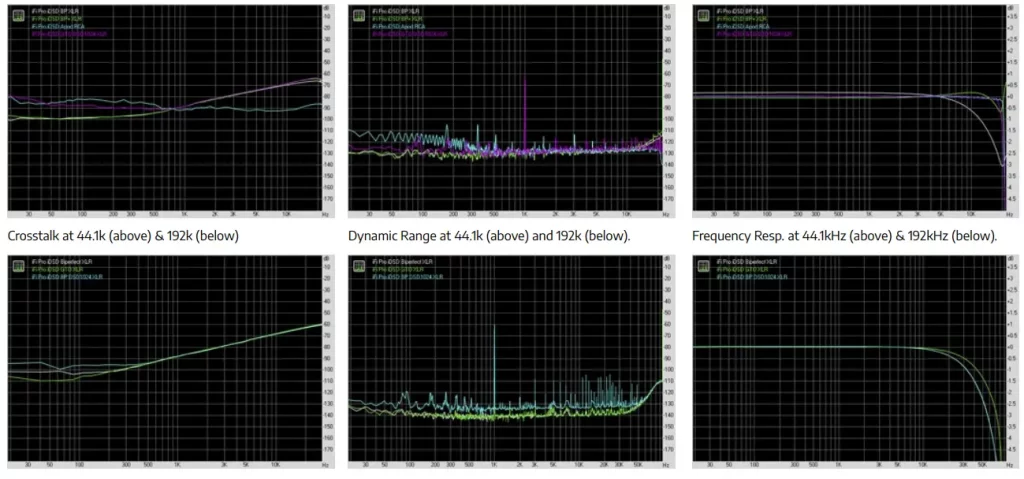
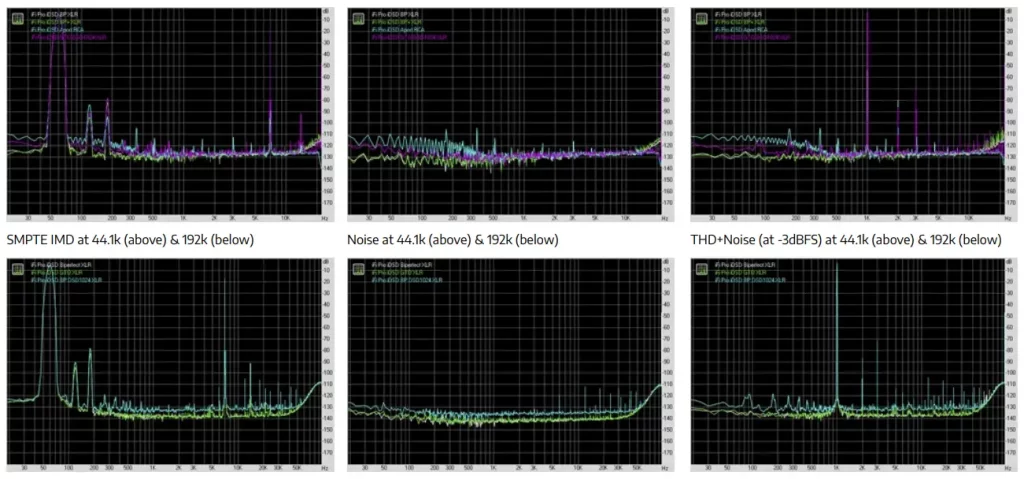
NETWORK AUDIO AND USB
I won’t spend much time on this. The short story is that it worked. You can stream music to the unit—once it’s connected—in several
different ways. That can be from DLNA sources, from certain Internet providers, and from iOS devices using Apple Airplay.
Naturally, I tried them. Airplay worked as it ought to, with the Pro iDSD appearing in the list of available ‘speakers’ and playing back the music perfectly. Like, Airplay, Spotify brought up the unit as a Spotify Connect ‘speaker’.
With DLNA I used an app on my phone to send music from my server to the Pro iDSD. It worked fine up to 96kHz but there was a lot of breakup with 192kHz files. (I couldn’t get the app to send DSD without conversion.) When I’d set up the Wi-Fi, I’d noticed that the options only showed the access points running in the 2.4GHz band, not the 5GHz band. I guessed that there was insufficient bandwidth available in my office, so I plugged in the Ethernet cable.
Thereupon nothing worked. My apps could no longer see the device. I went back into the web interface and found the ‘Restore Factory Settings’ function. Using that I wiped the WiFi connection. Then 192kHz worked well. But 384kHz sampled stuff didn’t come through at all, nor did it trigger the display readout. I am guessing that the unit doesn’t support stuff that high over the network.
Finally, I plugged in my standard USB memory stick to see if I could playback its contents. For that, I had to use the Muzo Player app because it provides access to additional inputs such as USB. It brought up a list of music files and almost all of them played—MP3, Apple Lossless, AAC, and FLAC.
It did not see the DSD test track, and I suspect the app is doing some conversion since the 96kHz ALAC test tracks were reported as 44.1kHz. In all cases, the unit’s front display showed PCM, not MP3 or whatever.
MEASUREMENTS
I measured the output impedance at around 2.9Ω with both the solid-state and valve output amplifiers. The unit would not clip into my test loads, even with the highest gain setting and the volume pushed up to the maximum. The output was a little hotter with the valve amp, running easily above 80mW into a 295Ω load, and well over 1,000mW into a 16Ω load. That means that the unit would push high-ish impedance headphones some 19dB above their sensitivity specification. As for low impedance headphones, they could do some serious damage at more than 30dB above sensitivity rating.
The transistor amp was no slouch though, managing respectively nearly 60mW and around 820mW, which translates into nearly 18dB and more than 29dB.
The frequency response depended very much on which filter one used. Let me cut to the chase: do not use either the Bit Perfect or the Bit Perfect+ filter. The first is so bit-perfect that it skips the output filter. 1kHz sine waves sampled at 44.1kHz present with a clear step pattern, while the response rolls off early.
Well, it rolls off early and then starts an uptick just before Nyquist. No filter means lots of harmonics, and they start to overpower the original signal at high frequencies. The Bit Perfect+ filter is like Bit Perfect, except that it boosts the high frequencies to counteract the natural roll-off. That means it’s flat much higher, but the kick-up still happens where one would normally expect a filter to cut in.
And, wow, the 1kHz sine wave is not just stepped, it actually goes up the slope, then comes back down a notch, then up again. It’s very weird.
All this stuff is probably not audible, but sometimes these filters are chosen to avoid weird-looking artifacts in test signals (for example, ringing on sine waves or transients), with little regard to them producing weird-looking artifacts in sine waves. Check out the 10kHz ones! But, as I say, you probably can’t hear any of them.
The noise performance from the line outputs was adequate with 24-bit signals, scoring a –108.4dBA from the balanced outputs when the DSD conversion was avoided, and –102.1dBA from the RCAs. For the purist, I’d just note that as a check I immediately measured a different, less expensive DAC using exactly the same test rig, since this was the first test I’d conducted with a new ADC I’m using it to acquire signals. Its RCA outputs managed noise levels of –115dBA.
I’d also note that THD+N was around 0.02% with those signals, compared to around 0.001% for the comparison unit.
Again, none of that should be audible.
Should you use the DSD1024 conversion?
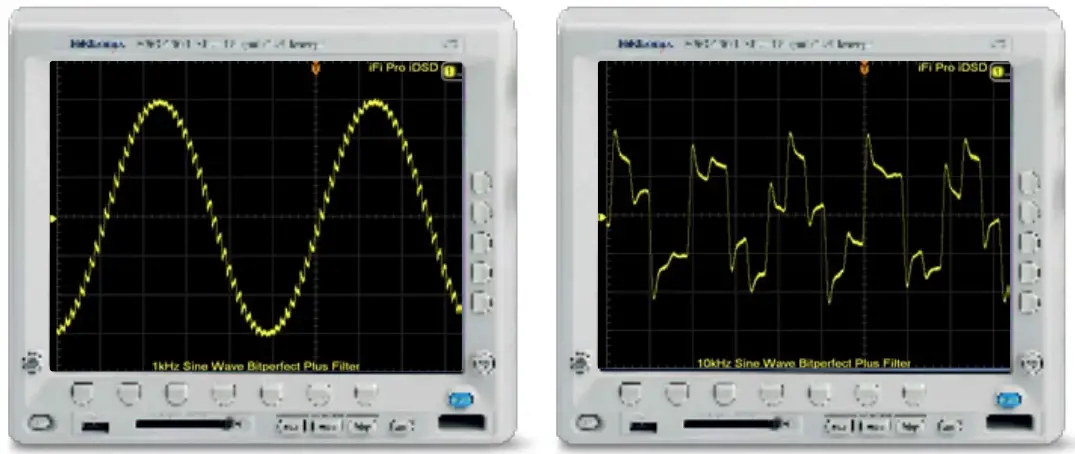
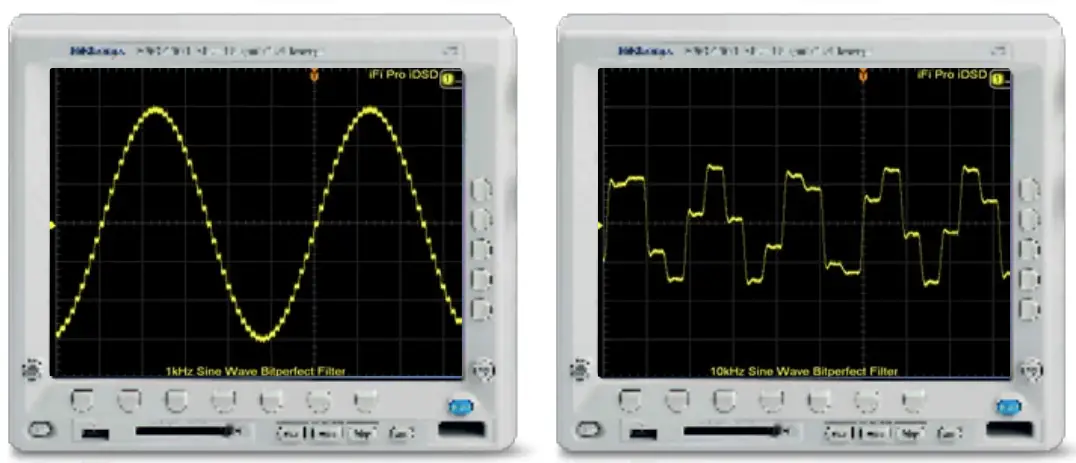
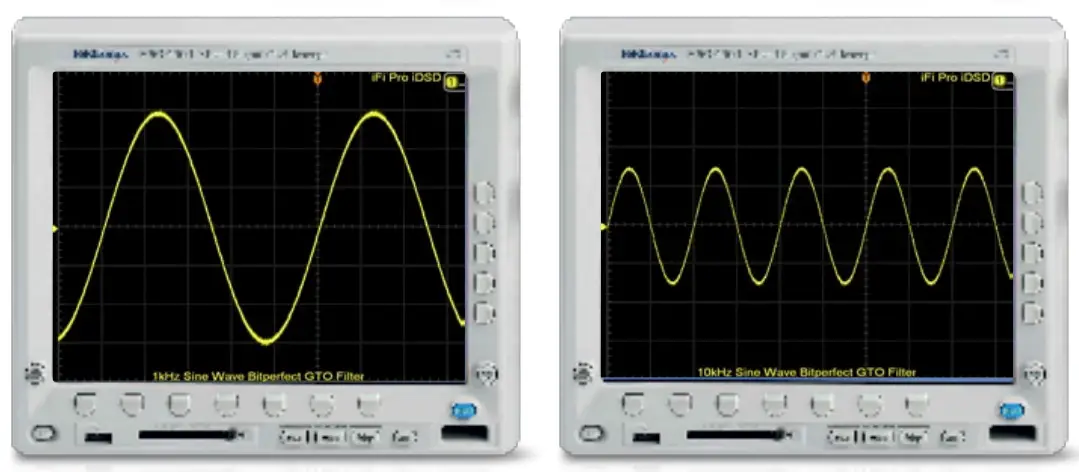
The frequency response with 192kHz signals, when converted to DSD1024, was identical to the response using the Bitperfect filter, which
had it hitting –3dB at a bit under 60kHz instead of a bit over 70kHz. But the noise performance was nearly 6dB worse using the DSD1024 filter. So I kind of think… no. Using the GTO (Gibbs Transient Optimised) filter gives the more extended response and the higher noise floor.
CONCLUSION
The iFi Pro iDSD DAC is an extraordinary unit. It covers digital signals that are verging on inconceivable and covers computer, USB, hi-fi-component, and streaming requirements. Plus it has a superb headphone stage. Yet it’s verging on affordable for the real enthusiast.
The only concerns I have are that the noise levels don’t measure as well as I’d expect for a DAC of this price, and then there’s strange
apparent mislabelling of the output control switch.  Stephen Dawson
Stephen Dawson
CONTACT DETAILS
Brand: iFi
model: Pro iDSD
rrp: $3,699 (2.5mm) / $3,999 (4.4mm)
warranty: One Year
distributor: BusiSoft AV Pty Ltd
Address: 158 Christmas Street
Fairfield VIC 3078
TF: 1300 888 602
T2: (03) 9810 2900
e: [email protected]
w: www.busisoft.com.au
 • Does everything
• Does everything
• Sounds great
• Affordable
 • HiFi/Pro Outputs
• HiFi/Pro Outputs
• BitPerfect+
• User Manual
Australian Hi-Fi